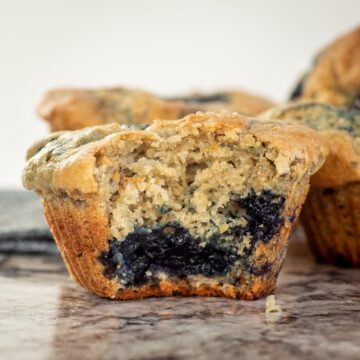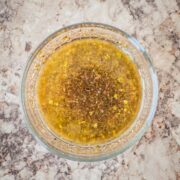If you have been wondering about baking muffins with oat flour, let me teach you how! After developing and testing dozens of recipes, I have come up with several recipes for classic muffins that are made specifically with oat flour and only oat flour. Read on for plenty of tips, how to measure oat flour and the recipes.
Jump to:
- Adapting Muffin Recipes to Use Oat Flour
- How to Measure Oat Flour For Muffins
- Oat Flour Muffin Tips for Success
- Storage
- Applesauce Muffins
- Banana Muffins
- Pumpkin Muffins
- Chocolate Chip Muffins
- Lemon Poppyseed Muffins
- Blueberry Muffins
- Cornbread Muffins
- Frequently Asked Questions
- Other Oat Flour Recipes
- Comments

An alternative to other gluten free flours, oat flour is a great option for baking. Made with just one wholesome ingredient, ground oats, it is easily accessible and relatively easy to work with.
With the right adjustments, an oat flour muffin can taste just as good (if not better!) in both texture and flavor as a classic all purpose flour version.
After testing literally hundreds of recipes for muffins using oat flour, I have learned plenty of tips to share with you and have developed specific recipes for several favorites made with oat flour.
NOTE: While oats (and oat flour) should technically be gluten free, there can be cross contamination in production. Therefore, if you need the oat flour recipe that you are making to be gluten free, use certified gluten free oat flour and oats.
Adapting Muffin Recipes to Use Oat Flour
After many test batches of adapting my favorite muffin recipes to be made with oat flour, I started to notice a few general patterns. If you are looking to adapt your own favorite wheat flour muffin recipe to oat flour, here is what I have generally found:
- Add 120 % oat flour by weight as compared to the wheat flour weight called for in the initial muffin recipe to achieve the most similar texture BUT remove 1 tablespoon of liquid for every 1 cup of oat flour.
- Oat flour muffins tend to take longer to cook or they will turn out gummy in the middle. Add about 3 minutes to the recipe cook time.
- Oat flour muffins tend to dry out a bit more quickly and are prone to being a bit crumblier.
*For Best Results: I recommend using the recipes that I have linked to below that have been formulated and tested to be made specifically with oat flour!

Is Store Bought or Homemade Oat Flour Better for Muffins?
In my testing, I found that generally store-bought oat flour yields more consistent results than homemade. Unless you have an excellent blender, it can be hard to repeatedly achieve the extremely fine consistency of flour.
*Therefore, I highly recommend using store-bought oat flour for muffins in order to get the most consistent results.
That said, if using homemade flour, your muffins will still taste good but the resulting texture will be more variable.
How to Make Your Own Oat Flour
But, if you are unable to get your hands on store-bought oat flour, you can make your own out of rolled oats. Large flake, quick or instant will all work*. DO NOT use steel cut oats.
Add the oats to a high powered blender or food processor and blend into a fine powder.
*If you need to have gluten free oat flour, ensure that you are using certified gluten free oats.

How to Measure Oat Flour For Muffins
I highly suggest using a kitchen scale to measure your oat flour. (For my recipes, toggle the recipe card to "metric" in order to get the exact measurement.)
Oat flour is less dense than wheat flour. While all purpose flour weighs 120 g per cup when spooned and levelled into a measuring cup, using the same method for oat flour will yield 80-90 g per cup.
However, after several trials, I have found that I consistently achieve 120 g per cup of oat flour (therefore comparable to AP flour and helpful when trying to substitute oat flour for part or all of AP flour in a recipe), by scooping the oat flour into a measuring cup, lightly packing it down and then levelling off the top (see the image below).
If you are not weighing your ingredients for any of my oat flour recipes:
- Scoop
- Lightly Pack
- Then Level Off

Oat Flour Muffin Tips for Success
To ensure delicious muffins every time, I suggest that you:
- Use an Oven Thermometer- Oven temperatures can vary a lot from what it is set to. Using a thermometer in your oven ensures that you are baking the cookies at the correct temperature.
- Don't Under-bake- Oat flour muffins will turn out gummy on the inside if under-baked. I have found 375 F to be the optimal temperature and about 23-25 minutes to be the optimal time for a standard sized muffin. I have also found it harder to over-bake than under-bake so if unsure, I recommend sticking to the longer time in the recipe.
- Cool Completely- While regular muffins can be scrumptious warm, I find the texture is much better in oat flour muffins once they have cooled completely.

Storage
To Store: Cool oat flour muffins completely on a wire cooling rack and then store in an airtight container at room temperature for up to 3 days or freeze for up to 3 months.
Oat flour muffins have a tendency to dry out quicker than wheat flour muffins, so if you don't plan on eating them right away, I recommend freezing them once they are fully cooled.
Applesauce Muffins

Banana Muffins

Pumpkin Muffins

Chocolate Chip Muffins

Lemon Poppyseed Muffins

Blueberry Muffins

Cornbread Muffins

Frequently Asked Questions
Yes! I have tested and created recipes for several popular kinds of muffins to specifically use oat flour.
When substituting oat flour in place of regular flour in muffins, the biggest affect that it has is on texture and binding. Oat flour muffins have a tendency to turn out more gummy when under-baked and can be a bit more crumbly because of the lack of gluten.
Two cups of rolled oats is equal to 200 g which is approximately 1 and ⅔ cups of oat flour when lightly packed and levelled.
Yes, oat flour is simply oats that have been ground into a fine, flour consistency.
No, oat flour and wheat flour have very similar caloric values. ¼ cup (30 g) of oat flour contains approximately 110 calories which is the same as ¼ cup (30 g) of all purpose wheat flour.
While oats should technically be gluten free, sometimes there can be cross contamination in the growth or production. If you need a recipe with oat flour to be gluten free, ensure that you use certified gluten free oats and oat flour.
Other Oat Flour Recipes
Want to learn more about oat flour? Check out these resources!
















Comments
No Comments